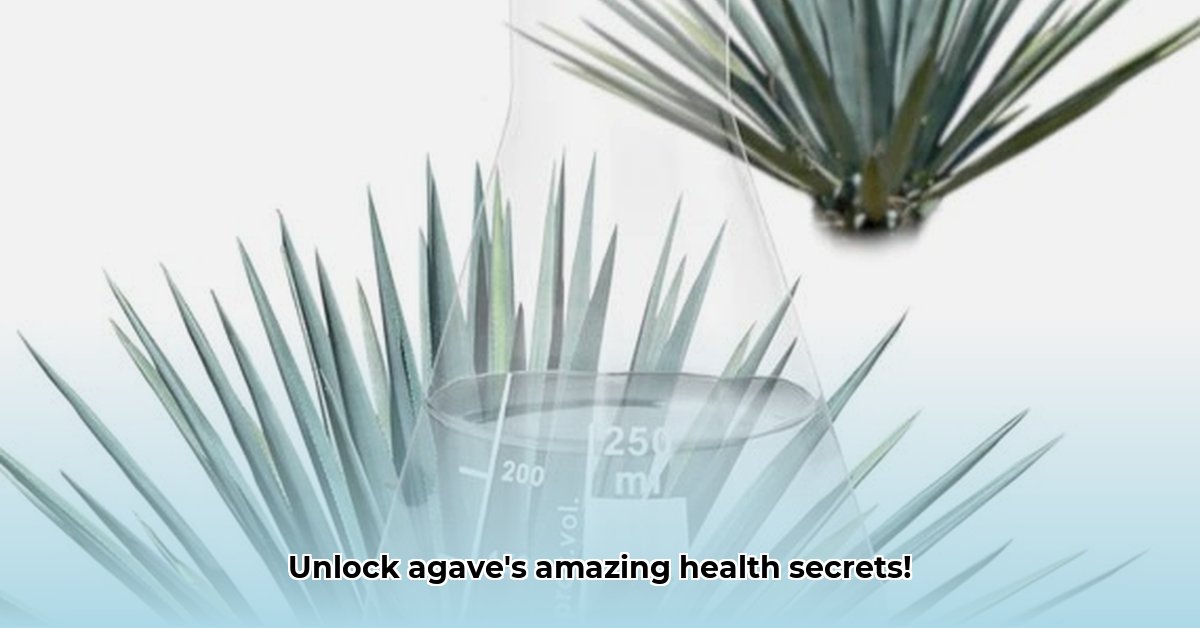So, you’re curious about agave? It’s everywhere these days – in your sweetener, your yogurt, even your face cream! But is it all good news, or are there downsides? This guide cuts through the confusion. We’ll explore both agave nectar (that sweet stuff) and inulin (the fiber part), looking at what’s good, what’s not so good, and how to use agave safely. We’ll cover everything from how it’s made, to its nutritional value, its potential health benefits (and risks!), and even its surprising uses in beauty products. By the end, you’ll have a clear picture of what agave is all about and how to make the best choices for you.
Agave Extract: Unveiling the Sweet Truth with a Natural Sweetener
Let’s explore the world of agave extract – a natural product with a lot of buzz, but also some unanswered questions. We’ll break down its two main components, agave nectar and inulin, to help you make informed choices about its use as a natural sweetener and dietary fiber. Agave is a complex topic, with both potential benefits and potential drawbacks, and it’s crucial for consumers to stay well-informed.
Understanding Agave Nectar and Inulin: The Sweet and the Fiber
Agave nectar, the sweet stuff, is made from the agave plant, a succulent native to Mexico. It’s become a popular natural sweetener, often touted as a healthier alternative to refined sugar. However, the story is more nuanced than that simple claim. Alongside the nectar, we find inulin, a type of fiber that’s gaining attention for its potential gut-health benefits. Think of it as the plant’s hidden, less sugary treasure, potentially improving overall well-being.
Agave Nectar: Production, Processing, and Potential Metabolic Issues
Making agave nectar involves extracting and refining the sap from the agave plant. The Agave tequilana, Agave salmiana and Agave americana plants are the most common species used. This process changes things significantly. Raw agave nectar undergoes less processing, retaining more of its natural vitamins and antioxidants. However, commercially available agave nectar usually goes through more extensive processing, which unfortunately removes many beneficial components – similar to how refining grains diminishes their nutritional value. It is extracted, filtered, and heated to create the product sold in stores.
This means the nutritional profile of agave nectar isn’t as straightforward as some marketing suggests. While it does contain small amounts of certain B vitamins and antioxidants, its high fructose content is a major point of concern. Agave also contains small amounts of riboflavin (vitamin B2), pyridoxine (vitamin B6), folate (vitamin B9) and vitamin K. High fructose consumption has been linked to negative health impacts, including metabolic problems and potential liver issues. This is why understanding how the nectar is processed and choosing wisely is crucial. Processed nectar often loses considerable nutritional value, so be mindful of this.
Agave Inulin: A Gut-Friendly Fiber Promoting Digestive Health?
In contrast to the sweeter agave nectar, inulin is a prebiotic fiber. This means it acts as food for the beneficial bacteria in your gut. Growing evidence suggests that a healthy gut microbiome is vital for overall well-being, potentially improving digestion, boosting immunity, and even influencing mood. However, is agave inulin a miracle worker? Probably not, and further studies are needed.
While studies show promising results, additional research is essential to fully grasp its effects on different individuals and over the long term. Like any dietary supplement, responses can vary considerably; some people might experience mild gastrointestinal issues. That’s why moderation is key when incorporating inulin into your diet.
Agave Extract in Cosmetics: More Than Just a Sweetener, it’s About Skin Hydration
Agave’s uses extend beyond the kitchen. Agave Americana Stem Extract appears in various cosmetics, celebrated for its moisturizing and skin-soothing properties. It is rich in vitamins B1, B2, C, D, K, and provitamin A, and has anti-inflammatory properties.
This is a completely different application compared to its use as food or sweetener. The risks associated with consuming large quantities of fructose simply don’t apply when using agave topically. It’s essential to remember the difference between ingesting and applying agave, and where benefits may come from.
Making Smart Choices: A Guide to Using Agave
The bottom line is simple: moderation is key. Focus on a diet rich in whole, unprocessed foods. Agave, in its various forms, can offer some benefits, but it shouldn’t be considered a magical health solution. The processing method and the specific type of agave extract matter considerably. Consider agave a special-occasion sweetener, not a dietary staple, so that you have the best outcome.
A Balanced Perspective on Agave Extract and Its Implication on Blood Sugar
Agave extract, whether it’s nectar or inulin, is a complex topic. Both offer potential advantages, yet come with potential drawbacks. As consumers, we need to stay well-informed and make thoughtful choices, choosing minimally-processed options when possible. Further research is vital to gain a clearer understanding of the long-term effects of agave consumption. This includes investigation into sustainable production practices to ensure responsible resource utilization. The journey toward understanding agave’s full potential is ongoing and has implications for blood sugar levels.
How to Choose the Healthiest Agave Nectar Brand and Reduce Metabolic Risk
Key Takeaways:
- Agave nectar’s health benefits are complex and depend heavily on its processing and consumption, so opt of high concentration to reduce metabolic risk.
- “Raw” agave isn’t always what it seems; look for certifications to verify claims.
- High fructose content raises long-term health concerns, and moderation is key.
- Sustainable farming practices are vital for responsible agave consumption to reduce environmental impact.
- Choosing a brand requires careful label reading and research for quality consumption.
Understanding Agave Nectar: Production and Nutritional Profile
Agave nectar, a natural sweetener, comes from the agave plant. But “raw” and processed nectars differ significantly. Raw agave, processed at lower temperatures, retains more enzymes and nutrients. However, even raw agave is primarily fructose—a simple sugar. This high fructose content is a key factor when you’re trying to determine how to choose the healthiest agave nectar brand.
The nutritional profile varies between brands and processing methods. While it offers a lower glycemic index than table sugar, meaning it doesn’t spike blood sugar as rapidly, the high fructose concentration still raises concerns, particularly with excessive consumption. Think of it like this: a lower glycemic index is a plus, but too much fructose can still have negative consequences that impact liver health.
Agave Inulin: A Prebiotic Powerhouse?
Agave also contains inulin, a type of fiber acting as a prebiotic. Prebiotics feed beneficial bacteria in your gut, potentially improving digestive health. Research suggests potential benefits, but more studies are needed to confirm long-term effects and optimal dosages. Remember, even a naturally occurring beneficial component should be consumed mindfully, as advised by nutritionists.
Health Implications: Weighing the Pros and Cons
Let’s get real: The health implications of agave nectar aren’t straightforward. The high fructose content is a double-edged sword. While its lower glycemic index initially seems appealing for blood sugar control, long-term, high consumption may mimic the negative health effects associated with high-fructose corn syrup. Potential risks include metabolic issues and liver problems.
Conversely, the inulin content offers potential gut health benefits. It’s a balancing act: enjoying the potential positives while mitigating the risks. This all directly impacts how to choose the healthiest agave nectar brand.
Agave in Cosmetics: A Different Story
Agave extract also finds its way into cosmetics, boasting moisturizing properties that make it a popular ingredient in lotions and creams. However, this is separate from its dietary considerations. The cosmetic uses don’t have the same health implications as consuming it, so it’s a completely different process. Agave Rigida (Sisal) Extract provides soothing and calming properties and is often used in hair care products.
Consumer Advice: Navigating the Agave Maze
So, how to choose the healthiest agave nectar brand? Here’s your guide:
- Check the Labels: Look for certifications like USDA Organic and Non-GMO Project Verified to ensure you are getting sustainable farming and processing methods.
- Scrutinize “Raw”: The term “raw” agave lacks standardization. Don’t solely rely on this label. Look beyond the marketing jargon for specific processing details.
- Mind the Fructose: Understand the high fructose content to avoid potential adverse effects. Limit your intake.
- Prioritize Transparency: Opt for brands transparent about their sourcing, farming practices, and processing methods, ensuring you have the best ingredients.
- Moderate Consumption: Agave, like any sweetener, should be enjoyed in moderation.
Choosing Wisely: A Sustainable Sweetener
Ultimately, making an informed choice about agave nectar requires careful consideration of its production, nutritional profile, and potential health implications. By being a conscious consumer, we can encourage the industry to adopt more sustainable and transparent practices. Prioritizing health and sustainability, we can harness the potential benefits of agave while minimizing its potential drawbacks, supporting a healthy lifestyle and environmental well-being.
The Ultimate Guide to Using Agave Extract in Cosmetics and How it Hydrates the Skin
Key Takeaways:
- Plant Based Diet Breast Cancer: Research-Based Benefits - December 16, 2025
- Plant-Based Diet Ulcerative Colitis Remission: Proven Benefits - December 15, 2025
- Plant-Based Diet and Fibroids: Reduce Symptoms Now - December 13, 2025










